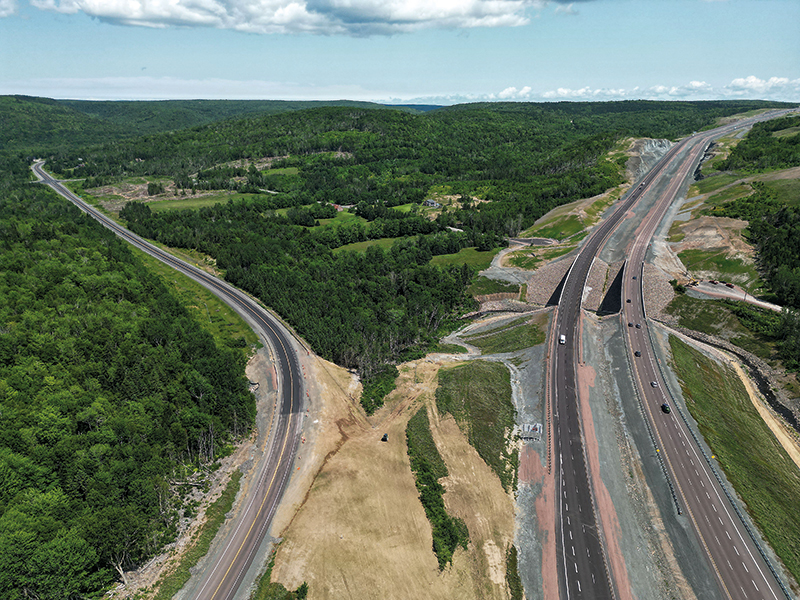By David McPherson
“If you build it, they will come.”
These whispered words Ray Kinsella hears in the middle of his Iowa cornfield in the 1989 feel-good film Field of Dreams resonate when talk turns to Nova Scotia’s Highway 104 Twinning project.
Number 78 on ReNew Canada’s Top100 Projects Report in 2023, the collaborative infrastructure investment featured more than one million labour hours. That’s impressive for any major construction project—where unexpected delays are common—but what makes this twinning even more impressive is that it was completed on time and on budget despite a global pandemic. Navigating new rules and protocols to make sure as little time was lost as possible (the initial project start date was only delayed by six weeks) and that workers remained safe, adds to this success story. It’s no surprise to learn the Minister of Public Works, the Hon. Kim Masland, is not the only one ecstatic and beaming with pride over the results.
“The day we opened the highway there were trucks travelling behind us and they were all laying on their horns with excitement,” says Minister Masland. “They were so happy to have this new section of the highway open. Our Premier says he wants to double our population to two million by 2060 … we need to make sure we have our highways and byways ready to rock ‘n’ roll!”
Masland’s colleagues, who use the recently opened twinned section of the 104 to commute to the Legislature from Cape Breton, also cannot stop raving about this incredible infrastructure feat. First opened in 1964, “The 104” as locals call it, is part of the Trans-Canada Highway, running 319.4 kilometres from the New Brunswick border to Antigonish, N.S. The project broke ground in July 2020 and the highway twinning was completed in July 2023. The twinning (the construction of a similar or parallel road to increase capacity to an existing road) saw the addition of 38 kilometres of highway from Sutherland River to Antigonish. The project also included environmental enhancements such as wildlife corridors and fencing to protect animals that call this part of the province home, upgrading and repaving the existing two-lane section of highway, adding two new interchanges, and building 24 new bridges.
The project significantly improves the highway network in the Cape Breton to the New Brunswick border corridor. The Highway 104 Twinning was delivered using a P3 (public-private partnership) model; Dexter Nova Alliance (DNA) is the consortium that the Nova Scotia Department of Transportation and Infrastructure Renewal (the former name of the Public Works department) chose following a Request for Quotation and Request for Proposal.
Included in the DNA-led consortium were Dexter Construction Company Limited, Nova Construction, BBGI Global Infrastructure and Municipal Enterprises Ltd. Beyond the twinning work now completed, as part of the contract, DNA is responsible for the operation and maintenance of an additional 25 kilometres of existing highway over a 22-year period. Having a pair of local companies as part of the consortium (Dexter Construction and Nova Construction) and sharing duties also helped pave the way to a successful finish. Despite normally being competitors, on this project they showed that when you have a common goal for the greater good rivals can work together efficiently and effectively.
As the project neared completion late last summer, Ken MacLean, chair, Dexter Nova Alliance GP, shared his joy at this project’s success.
“We are proud to work on a project of this magnitude that has provided employment to so many locals,” said MacLean. “This highway was built for Nova Scotians by Nova Scotians. Thanks to our local workforce and many companies and suppliers, together, they worked tirelessly for three years to bring this project to completion on time and on budget.”
Safety first
From the ceremonial first shovel in the ground to the official opening, safety was the No. 1 concern for everyone involved and is what drove this project. Since 2009, there have been 391 collisions, including 19 fatalities and 14 fatal collisions in the previously untwinned portion of the highway. Every day, thousands of Nova Scotians use the 104 to commute from the South Shore of the province to work in Halifax. With remote work, changing lifestyles, and many reassessing their day-to-day quality of life, many have been attracted by the beauty, natural wonders and lower cost of living Nova Scotia and the Atlantic provinces. The combination of an increased population with more commuter traffic means infrastructure is—and remains—a top priority for the current government.
“Twinned highways help to keep Nova Scotia drivers safe,” says Masland. “The 104 was an extremely dangerous section of highway. Every death on a Nova Scotia highway or road is a tragedy; one death is too many. As Minister of Public Works, I want to make sure our highways are safe for folks to travel on.”
In the Five-Year Highway Improvement Plan, published in January 2023, the Public Works department outlines the importance of infrastructure projects in Nova Scotia. The document maps out the current government’s approach to repairing and maintaining the province’s 23,000 km of roads and highways and 4,100 bridges. According to this report, the road building industry in Nova Scotia is big business: creating more than 6,000 direct and 3,000 indirect positions annually. For 2023-2024, the Nova Scotia government’s total highway capital budget was expected to approach $500 million.
“We made sure we completed that job,” Masland says. “And we will keep going. Infrastructure and improving our highways and byways are a focus of our government, but we also need to invest in our local roads and routes that rural Nova Scotians drive every day.”
A highway in harmony
Apart from safety, a concern for the environment—the wildlife (both aquatic and land) that calls the 38 km stretch between Sutherland’s River and Antigonish home—and the established eco-systems in this corridor were paramount. Part of the project team included environmental experts that implemented an Environmental Management System that complied with the International Standard for Environmental Management Systems (ISO 14001). “The wildlife corridors and fencing that were built are incredible,” Masland comments. “Nova Scotia has a large deer population, especially in that area. That alone saves lives from people hitting deer and causing accidents.”
Replacing aging infrastructure and removing concrete culverts in the fish-bearing watersheds helped to improve system connectivity and addressed fish populations in the river systems that flow throughout this region. Where necessary, fish were rescued and moved to safer waterways during construction. On land, the aforementioned fencing was incorporated into the project’s design to make sure the highway was safer for both drivers and wildlife. And, prior to any construction starting on this project, wildlife surveys for species like birds, bats, turtles, and protected species of trees and lichen were conducted.
Three months following the official opening of the Highway 104 Twinning project Minister Masland still beams with joy.
“What I’m most proud of is that this is a highway built for Nova Scotians by Nova Scotians,” she concludes. “I saw that the day it reopened. You could see the pride on everyone’s face that was there to celebrate. It takes a village to raise a child; well, this took a very strong partnership to create a twinned highway like they delivered.
“Our government is putting a focus on further twinning,” the minister adds. “We recently announced a further section of twinning on the 104 and we are also doing twinning on the 103, the highway that I drive every day. I don’t care what anyone says, twinning saves lives.”

Twinning Tales
- Moved 5.6 million cubic metres of earth—enough dirt and rock to fill 2,240 Olympic-sized swimming pools.
- Laid over 320,000 tonnes of asphalt. That’s roughly the same as more than 150 football fields.
- The project created more than two million hours of employment, or the same as hiring 300 people full-time for 40 months.
- Environmental enhancements include wildlife corridors, fencing and improved culverts that restore upstream fish passage.
David McPherson is the author of The Legendary Horseshoe Tavern: A Complete History, Massey Hall and 101 Fascinating Canadian Music Facts. He is also the president of McPherson Communications, based in Waterloo, Ont.
[This article originally appeared in the January/February 2024 edition of ReNew Canada]
Featured image: The City of Vancouver has plans to transition to zero-emissions buildings in all new construction by 2030. (Nova Scotia Department of Public Works)












